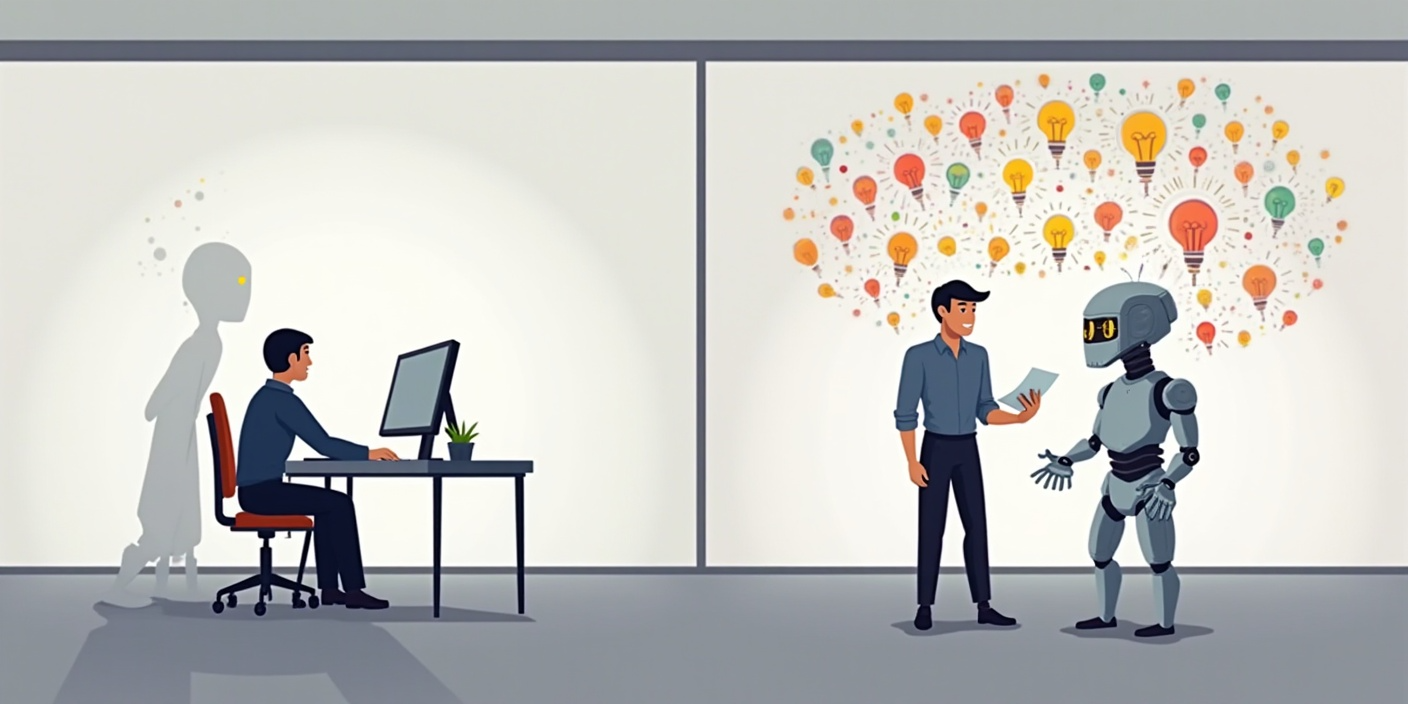AI Co-Scientist
Highlights
Top Insight
Firms should integrate human-centered design into AI initiatives by mandating early-stage user testing with diverse, non-technical participants to uncover hidden usability barriers. Rather than focusing solely on AI’s technical capabilities, they should prioritize identifying friction points in real-world adoption and adjust accordingly. Encourage cross-disciplinary teams—including ethnographers, behavioral scientists, and designers—to challenge engineering assumptions and uncover alternative use cases. Adopt a “reverse roadmap” approach, starting with the desired human experience and working backward to determine AI’s role, rather than leading with technology. Finally, embed sustainability and ethical sourcing criteria into design decisions, not as a compliance requirement, but as a core driver of long-term brand loyalty, particularly among younger demographics.
Top News
1. Google’s AI Co-Scientist solved in two days a complex superbug resistance problem that took scientists a decade.
2. xAI has unveiled Grok-3, an advanced AI chatbot featuring a DeepSearch reasoning tool.
3. Fiverr’s developer platform, Fiverr Go, is enabling industry-specific AI models trained on real-world transactional data.
4. Researchers have developed a generative model, WHAM, that can produce consistent and diverse gameplay sequences.
5. Scientists have released Evo-2, the largest-ever AI model for biology, that can generate DNA sequences from scratch.
Innovation Insights
1. In the Age of AI, Human-Centered Design is Crucial (IDEO)
Human-centered design is essential for integrating AI into daily life, just as past technological shifts, like personal computing, required a deep understanding of user needs to succeed. IDEO’s experience with designing the Apple mouse and other innovations demonstrates that the key to impactful technology lies not just in engineering capabilities but in making products intuitive and accessible. As AI continues to evolve, companies must involve users early in the design process to ensure relevance and adoption, rather than focusing solely on technical feasibility. Beyond AI, ethical and environmental considerations are becoming central to design, with younger generations demanding more transparency and responsibility from brands.
2. Your most important customer may be AI (MIT Technology Review)
As AI-driven recommendations become more influential, brands are increasingly focused on how AI perceives their products, much like an advanced form of search engine optimization. Tools like Share of Model help businesses assess and refine their AI image, as seen with Ballantine’s whisky, which was mistakenly categorized as a premium product by some models. The ability to influence AI is still evolving, but research shows that small adjustments, from modifying online assets to tweaking recommended prompts, can significantly impact AI-generated suggestions. However, AI’s inherent biases, such as favoring global brands over local ones or associating luxury with high-income consumers, raise concerns about fairness in recommendations. As AI becomes a powerful gatekeeper for consumer choices, brands must navigate a complex landscape of influence, adaptation, and ethical considerations to stay competitive.
3. Calculating the ROI of AI strategy (Board of Innovation)
AI investments are shifting from experimental initiatives to real impact, with organizations needing to strategically calculate ROI by categorizing use cases into cost efficiency, revenue optimization, and new revenue streams. AI adoption unfolds in three waves: initial cost and efficiency gains, improved quality and output, and full-scale transformation through interconnected AI systems, requiring a long-term vision. Prioritization is key—whether focusing on a single AI use case with measurable KPIs or comparing multiple options using structured ROI frameworks to maximize impact. Businesses can significantly enhance returns by linking AI applications together, creating a compounding effect where insights from one system improve others. Ultimately, AI’s flexibility is powerful, but without strategic focus, businesses risk inefficiency; success depends on aligning AI investments with business goals, ensuring data readiness, and planning for long-term transformation.
4. The CIO’s Role in AI Value Creation (BCG)
GenAI is generating excitement across industries, yet only 26% of companies have realized its value, with many struggling to scale due to legacy IT limitations. CIOs play a crucial role in overcoming these barriers by optimizing IT productivity, leading AI-driven innovation, and establishing scalable architectures. Key use cases, including programming assistants, IT service automation, and knowledge management, can drive efficiency gains of up to 30%, but adoption remains low. Successful GenAI deployment requires a strategic approach, balancing cost considerations, process reengineering, vendor negotiations, and strong change management. By leading responsible AI initiatives, ensuring regulatory compliance, and mitigating risks like shadow IT, CIOs can position IT as a core innovation partner, accelerating AI transformation and business growth.
AI Innovations
1. Language Models
Elon Musk’s xAI has unveiled Grok-3, an advanced AI chatbot designed to rival ChatGPT and China’s DeepSeek, featuring a new DeepSearch reasoning tool and launching with a SuperGrok subscription tier, as xAI expands its AI capabilities with massive data center investments (Reuters).
Mistral has launched Mistral Saba, a 24-billion-parameter language model optimized for Arabic-language interactions, aiming to expand its presence in the Middle East while also supporting South Indian languages, positioning itself as a global alternative to U.S. and Chinese AI firms (TechCrunch).
Nous Research has launched DeepHermes-3, an 8-billion-parameter AI model with a toggleable reasoning mode, allowing users to switch between fast, intuitive responses and deep, structured reasoning, positioning it as a flexible, open-source alternative to advanced reasoning models like DeepSeek-R1 (VentureBeat).
Perplexity has open-sourced R1 1776, a post-trained version of DeepSeek-R1 designed to provide unbiased, factual, and censorship-free responses, particularly on sensitive topics, while maintaining its high reasoning and mathematical capabilities, available for download via HuggingFace or through the Sonar API (Perplexity).
2. Tools and Platforms
2.1 Video
Pika Labs has launched Pikaswaps, an AI-powered video inpainting tool that allows users to swap objects in videos using text prompts, brush selections, or reference images, enabling seamless modifications for creative applications like object replacement, fashion try-ons, background changes, and AI-enhanced animations (Pika Labs).
2.2 Developer platform
Fiverr’s new developer platform, Fiverr Go, is redefining AI development by enabling specialized, industry-specific AI models trained on real-world transactional data, offering built-in monetization and human-in-the-loop collaboration, potentially reshaping the AI landscape from a race for scale to a focus on practical, commercially viable applications (Entrepreneur).
2.3 Search
Perplexity’s Deep Research is a powerful AI tool that conducts expert-level research by autonomously searching, analyzing, and synthesizing information from hundreds of sources in minutes, delivering comprehensive reports across various domains like finance, marketing, and technology—now available for free with unlimited access for Pro subscribers (Perplexity).
2.4 Agent
Proxy 1.0, an AI agent by Convergence AI, automates online tasks by taking control of a user’s mouse and keyboard, efficiently handling shopping, travel planning, and weather searches. It operates slower than manual execution but excels in task persistence and problem-solving (TechRadar).
3. Gaming
Using GenAI to support ideation in creative industries is common yet challenging. For game development, researchers have developed a generative model, WHAM, that can produce consistent and diverse gameplay sequences and sustain user modifications (Nature).
Elon Musk’s xAI has announced a new AI-powered gaming studio leveraging Grok 3 to develop photo-realistic AI-generated games, though early demonstrations have only showcased simple 2D titles, with ambitions to enhance graphics resolution and dynamically generate complex game environments (Tom’s Hardware).
4. Robotics
Silicon Valley startup Figure has unveiled Helix, a breakthrough AI model that enables humanoid robots to autonomously interact with new objects, collaborate, and perform complex tasks without extensive training, marking a step toward AI-powered home robotics (Inc).
5. Science and Medicine
Researchers have developed an AI tool that diagnoses multiple diseases, including COVID-19, HIV, type 1 diabetes, and lupus, by analyzing immune-cell gene sequences from blood samples, showing high accuracy but requiring further refinement before clinical use (Nature).
Researchers have used AI-driven protein design to create a multi-step enzyme capable of breaking down plastics, leveraging tools like RFDiffusion and PLACER to refine its structure and catalytic efficiency, marking a breakthrough in enzyme engineering for environmental applications (Ars Technica).
Researchers are training AI to interpret animal emotions and pain by analyzing facial expressions in species like pigs, dogs, and horses, with systems like Intellipig and facial recognition models achieving high accuracy in detecting discomfort and distress (TechCrunch).
Scientists used AI to design the lightest and strongest nanomaterial ever, a carbon nanolattice that is strong as steel but light as foam, capable of balancing on a soap bubble while supporting over a million times its mass, with potential applications in aerospace, defense, and medical technology (Popular Mechanics).
Scientists have released Evo-2, the largest-ever AI model for biology, trained on 128,000 genomes to generate DNA sequences from scratch, interpret non-coding genetic regions, and design new gene-editing tools and synthetic genomes, marking a major step toward AI-driven genome engineering (Nature).
Google has introduced AI Co-Scientist, a multi-agent AI system built on Gemini 2.0 designed to assist scientists by generating novel hypotheses, research proposals, and experimental protocols, already demonstrating its potential in drug repurposing, target discovery, and antimicrobial resistance research, with early real-world validations and a Trusted Tester Program for broader scientific collaboration (Google). Google’s AI Co-Scientist solved in two days a complex superbug resistance problem that took scientists a decade, confirming their unpublished hypothesis and generating additional insights, with researchers believing this breakthrough could revolutionize scientific discovery (BBC).
Microsoft has introduced BioEmu-1, a deep-learning model that accelerates the study of protein structural changes, enabling thousands of structural predictions per hour, offering new insights into protein function, drug development, and disease research, now available as an open-source tool for scientists (Microsoft).
MIT researchers have developed FragFold, an AI-powered computational method that predicts protein fragments capable of binding to and inhibiting target proteins, demonstrating high accuracy in identifying functional interactions, with potential applications in drug discovery, protein engineering, and cellular research (MIT).
Other Innovations
1. Quantum computing
Microsoft claims to have created the first “topological qubits” for quantum computing, which could enable more scalable machines, but some physicists remain skeptical due to limited publicly available evidence and past controversies (Nature).
2. Gene therapy
MeiraGTx’s investigational gene therapy restored vision in 11 children born legally blind due to AIPL1-associated severe retinal dystrophy, demonstrating strong clinical efficacy and prompting the company to seek accelerated approval in the U.K. and U.S. (Fierce Biotech).







